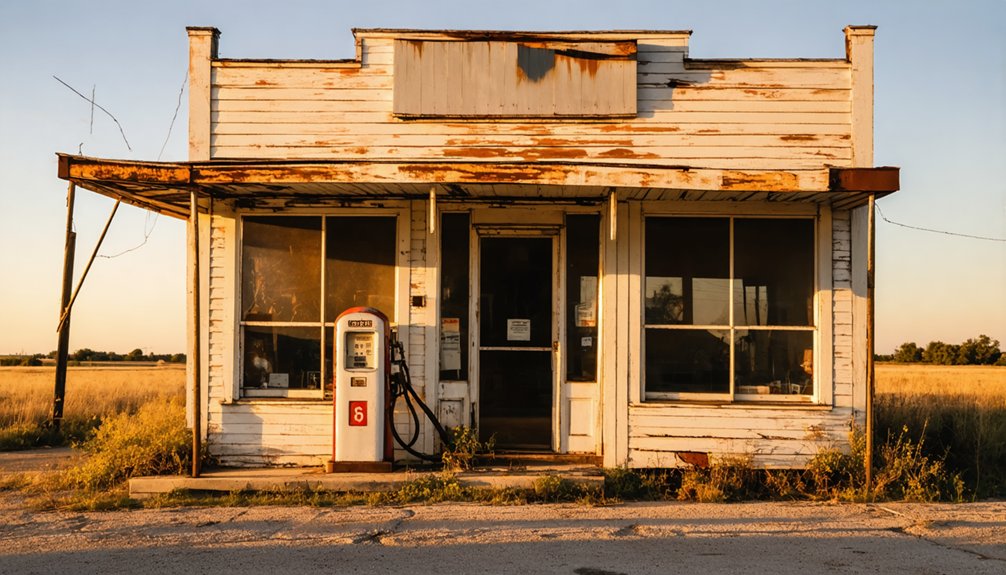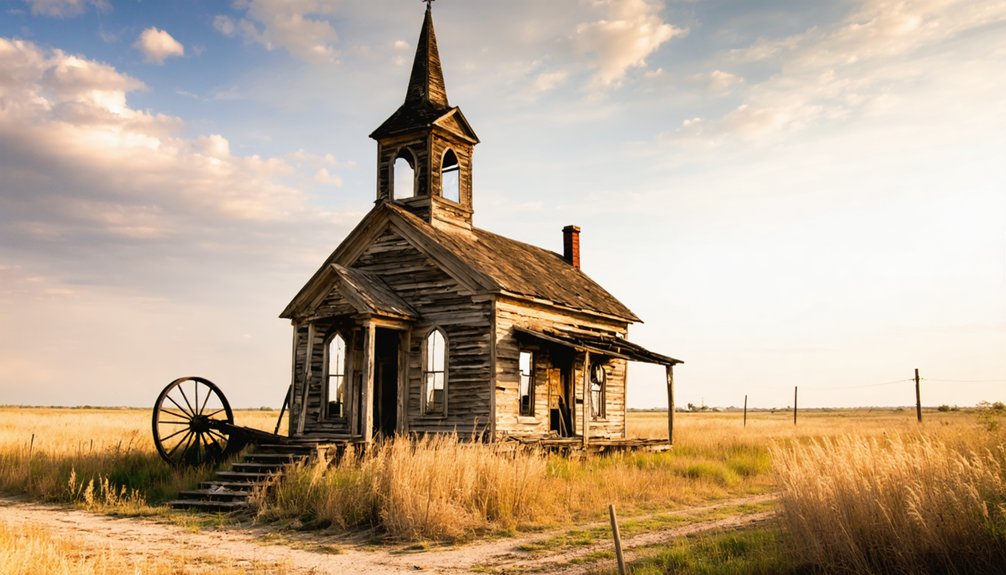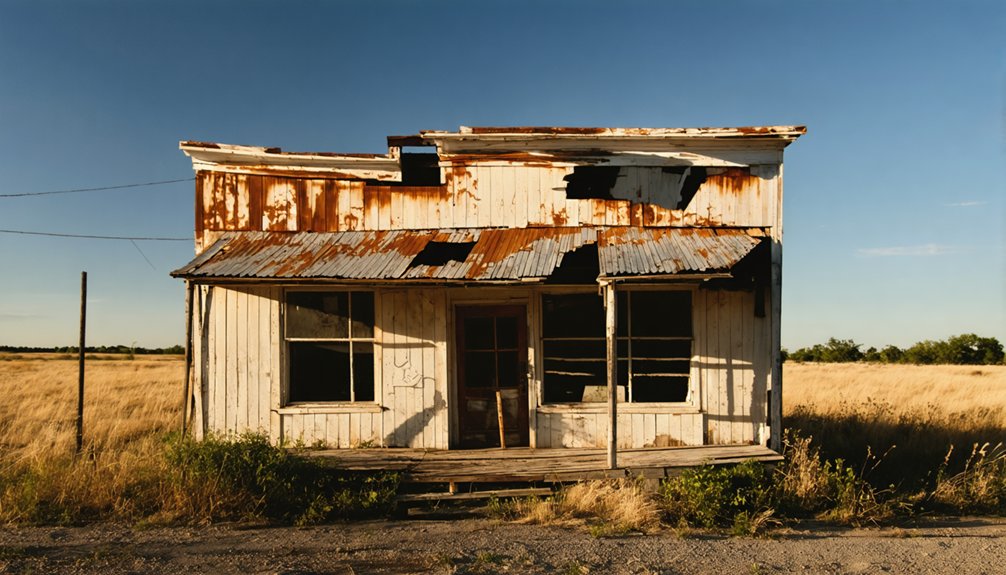You’ll find Mill Creek’s ghost town remnants in Washington County, Texas, where a once-bustling sawmill community thrived in the 1800s. Originally called Palmetto Creek, it developed around the Cumings family mill, processing both cotton and timber. The town faced devastating setbacks, including the catastrophic 1935 flood that brought 24 inches of rain in 6 hours. While nature now reclaims the site, preserved architectural ruins and adobe structures reveal compelling stories of Texas’s industrial past.
Key Takeaways
- Mill Creek transformed from a bustling timber processing center in the late 1800s to a ghost town following forest depletion and economic decline.
- The community’s downfall accelerated after the devastating 1935 flood, which brought 22-24 inches of rainfall within six hours.
- Architectural remnants, including adobe brick homes and wooden structures, stand as testament to the town’s mining and industrial heritage.
- The site now features deteriorating walls, protective fencing, and warning signs, while nature reclaims the former settlement with vegetation.
- Mill Creek exemplifies post-Civil War Texas development, showing the transition from thriving rural community to abandoned ghost town.
Origins and Early Settlement
Situated along two converging branches in central Austin County, Mill Creek began as Palmetto (Palmito) Creek before assuming its new name in either the early 1820s or 1845.
Similar to many historical settlements in East Texas, the town’s destiny was deeply influenced by railroad development and economic shifts.
The creek’s strategic location, with its East and West Forks rising near Burton, Texas, attracted early settlers seeking natural resources and water power.
You’ll find the community’s roots deeply tied to the Cumings family, who established a crucial mill along the waterway. The mill later served as a cotton gin facility that helped drive the local economy.
Settlement patterns emerged in the mid-1800s as families carved out homesteads on the level to moderately sloping terrain.
The area’s clay soils supported diverse agricultural practices, while post oak forests provided essential timber.
The community flourished on the east bank of the upper East Fork, roughly five miles west of Brenham, becoming a significant hub for local farming operations.
The Mill’s Rise and Fall
As the lumber industry boomed across East Texas in the late 1800s, Mill Creek emerged as a significant timber processing center, capitalizing on its abundant forest resources and strategic location near transport routes.
You’ll find the town’s economic resilience was initially strong, with sawmills processing pine and hardwood while supporting a growing community of workers and their families. The community exemplified the era’s boom towns that flourished across the region. Like the coal miners of Thurber, the mill workers received their wages through a restrictive once-a-month paycheck system.
The timber legacy that once defined Mill Creek began to fade by the 1920s.
You can trace the town’s decline to the depletion of virgin forests, which forced mills to reduce operations or shut down completely.
The Great Depression dealt another blow, accelerating business closures and population loss.
Without its timber-based economy and unable to attract new industries, Mill Creek’s liveliness dwindled, leaving behind abandoned buildings and deteriorating infrastructure.
Natural Disasters and Adaptation
You’ll find that Mill Creek’s fate was sealed by the devastating 1935 flood, which destroyed much of the original mill structure and forced a significant operational shift.
Recent history shows that Mill Creek continues to face serious flooding challenges, with major floods occurring in both 2010 and 2021.
The mill’s owners attempted to adapt by converting the remaining infrastructure into a small hydroelectric facility, hoping to maintain the site’s economic viability. Much like Indianola’s two hurricanes, nature’s destructive power proved too overwhelming to overcome.
Local residents rallied to preserve what remained of the historic structure, but their efforts couldn’t prevent the gradual decline that would eventually transform Mill Creek into a ghost town.
Devastating 1935 Flood Impact
The catastrophic 1935 flood that struck Mill Creek marked one of Texas’s most destructive natural disasters, with rainfall reaching an extraordinary 22-24 inches within just 6 hours.
You’d have witnessed floodwaters surging beyond any previously recorded levels, with peak discharges exceeding 1,500 cubic feet per second per square mile throughout the region’s tributaries.
The devastation forced thousands of families to evacuate as the raging waters destroyed homes, bridges, and essential infrastructure.
Your community’s water supply systems were interrupted, and farmlands vanished beneath the deluge.
The flooding coincided with devastating impacts across Texas, including the complete inundation of downtown Houston during the same year.
These events ultimately led to the creation of the Brazos River Authority in 1935 to better manage flood control and water resources.
Historical documentation reveals the flood recovery efforts sparked significant changes in Texas’s approach to disaster management, though Mill Creek itself saw limited infrastructure improvements.
The event’s unprecedented intensity ultimately contributed to the area’s eventual decline, marking a pivotal moment in local history.
Mill’s Hydroelectric Conversion
Despite recurring flood challenges in the region, Mill Creek’s ambitious hydroelectric conversion project emerged as a pioneering feat of engineering during the late 19th to early 20th century.
You’ll find evidence of advanced hydroelectric technology in the system’s design, which featured multiple 1,000 K.V.A. generators connected to vertical turbines producing 2,400 horsepower.
The conversion’s most innovative features included 15-foot automatic wooden floodgates and Pelton water wheels paired with Lombard Governors for precise flow control.
Engineers designed the system to generate three-phase AC power at 60 cycles, compatible with regional power grids. They also incorporated flood-resistant elements, combining masonry dam structures with modern concrete and improved tailrace channels. The facility maintained auxiliary steam plants as backup power sources during periods of insufficient water flow.
This cutting-edge power generation system represented Texas’s growing commitment to hydroelectric development, despite the persistent threat of natural disasters.
Community Response After Disaster
Following Mill Creek’s devastating 1935 flood, residents launched intensive reconstruction efforts that fundamentally transformed the community’s infrastructure and economic foundation.
You’ll find their community resilience reflected in how they repurposed the damaged mill into a hydroelectric power plant, demonstrating remarkable adaptability in the face of crisis. Similar to how Indianola was devastated by multiple hurricanes in the 1800s, Mill Creek faced nature’s fury head-on.
Despite these innovative efforts at disaster preparedness, the economic strain proved too severe.
You can trace the town’s decline through the gradual exodus of residents seeking safer ground and better opportunities elsewhere.
While some maintained emotional ties to Mill Creek, few returned permanently.
The abandoned structures you see today stand as evidence to both the determination of those who tried to rebuild and the harsh realities that ultimately led to the town’s ghost status.
Community Life and Local Economy

While Mill Creek flourished during its peak years, several hundred inhabitants formed a tight-knit community centered around agriculture and milling operations. The town’s economic innovation and community resilience were evident in its diverse business landscape, which supported daily life and commerce.
Mill Creek’s success grew from its close-knit community of farmers and millers, whose innovative spirit created a thriving local economy.
Key features of Mill Creek’s vibrant community included:
- Local mills that processed grain and lumber from surrounding cedar forests
- Small businesses including general stores and blacksmith shops that served residents’ needs
- Hotels and racetracks that attracted visitors and boosted regional trade
- Religious institutions and schools that strengthened social bonds
You’d find townspeople gathering regularly at community events, from fairs to church meetings, while supporting one another through economic and environmental challenges.
This interdependence proved essential for maintaining community spirit despite the hardships that would eventually lead to the town’s decline.
Architectural Remnants Today
Today in Mill Creek, you’ll find a haunting collection of architectural remnants that tell the story of this once-thriving Texas settlement. Adobe brick homes and wooden frame structures stand in various states of decay, with most buildings now roofless or reduced to foundations.
While architectural styles reflect the town’s mining heritage through vernacular design and minimal ornamentation, you’ll notice later additions of cement block cabins featuring round nails and early 20th-century materials.
Nature has begun reclaiming the site, with trees and wildflowers growing alongside deteriorating walls. Though preservation efforts include protective fencing and warning signs, most structures continue to weather away.
Mining equipment ruins and stone wall remnants punctuate the landscape, creating a stark contrast against the natural sandstone cliffs that surround this abandoned piece of Texas history.
Historical Significance in Texas

When you explore Mill Creek’s origins, you’ll find a quintessential example of post-Civil War Texas development, where the 1870s establishment of a water-powered grist mill sparked settlement in western Bandera County.
The mill’s transformation from a grain-processing facility to a hydroelectric plant in 1935 showcases the industrial adaptability that characterized Texas Hill Country communities.
Mill Creek’s evolution from a thriving rural hub to a ghost town mirrors the broader pattern of Texas settlement history, where changing economics and technologies reshaped the rural landscape.
Early Mill Settlement Development
During the 1850s, Mill Creek emerged as a promising settlement in Guadalupe County, Texas, where early pioneers established a self-sufficient agricultural community around its namesake waterway.
You’ll find the settlement’s agriculture focused on essential crops and livestock, while local mills processed harvests for the region’s growing population.
The early community quickly developed around four key pillars:
- Family-operated farms capitalizing on the area’s fertile soil
- Water-powered mills serving as the economic backbone
- Churches fostering social bonds and mutual support networks
- Schools educating the settlement’s youth and strengthening community ties
Mill Creek’s strategic location and abundant water source attracted settlers seeking independence through farming, creating a tight-knit community that exemplified the spirit of early Texas settlement agriculture.
Industrial Heritage Impact
Mill Creek’s industrial legacy stands as a tribute to Texas’s early sawmill era, where innovative timber processing shaped the economic landscape of emerging frontier towns.
You’ll find evidence of this once-thriving timber economy in the mill’s remnants, which processed substantial quantities of lumber essential for frontier development and trade.
The site’s significance extends beyond its industrial footprint. As a hub of technological innovation, the mill incorporated advanced logging equipment like the Fletcher loader and mechanical winches that revolutionized timber harvesting.
The operation fostered a vibrant community complete with schools, stores, and worker housing. Even after the Great Depression forced its closure, Mill Creek’s industrial heritage continues to provide valuable insights into Texas’s resource-driven economic transformations and the boom-and-bust cycles that shaped the state’s development.
Regional Settlement Pattern Example
The emergence of Mill Creek exemplifies the typical settlement patterns that shaped nineteenth-century Texas development.
Like many frontier communities, its location near natural water resources attracted diverse settlers seeking opportunities in the post-Civil War era. Cultural influences and settlement diversity played key roles in establishing the town’s character.
You’ll find Mill Creek’s development followed these common regional patterns:
- Initial settlement driven by natural resource proximity
- Population growth marked by establishment of essential infrastructure like post offices
- Community formation shaped by both agricultural prospects and racial demographics
- Economic sustainability tied to transportation access and resource availability
As with many Texas ghost towns, Mill Creek’s story reflects the broader regional trend of boom-and-bust cycles that characterized 19th-century settlement expansion in the state’s rural areas.
Frequently Asked Questions
Are There Any Ghost Stories or Paranormal Activities Reported at Mill Creek?
Like a whispered secret lost to time, you won’t find documented ghost sightings or haunted locations here. Despite the eerie ruins that could spark supernatural tales, no credible paranormal activities have been reported.
What Wildlife and Plant Species Currently Inhabit the Abandoned Town Site?
You’ll spot white-tailed deer, coyotes, and raccoons among diverse wildlife observations. The site’s plant diversity includes cottonwoods along creek banks, post oaks, and seasonal bluebonnets in open spaces.
Can Visitors Legally Explore the Mill Creek Ruins Today?
Like footprints in shifting sands, your legal access to these ruins isn’t clearly marked. You’ll need to verify exploration regulations with local authorities since ownership status determines whether you can visit.
Did Any Notable Historical Figures Ever Visit or Live in Mill Creek?
You won’t find records of famous visitors or notable residents in Mill Creek’s documented history. The quiet farming community lacked historic landmarks that typically attracted prominent figures to Texas ghost towns.
What Artifacts Have Been Discovered and Preserved From Mill Creek’s Past?
From water wheels to cherished photographs, you’ll discover preserved artifacts including industrial machinery, household items, German immigrant belongings, and architectural remnants that tell the profound story of this historic settlement’s significance.
References
- https://mix931fm.com/cherokee-county-ghost-towns/
- https://www.youtube.com/watch?v=-vvRF4-YC9w
- https://www.southernthing.com/ruins-in-texas-2640914879.html
- https://en.wikipedia.org/wiki/Tigertown
- http://fortworthgazette.blogspot.com/2011/04/ghost-towns-on-brazos-shades-of.html
- https://en.wikipedia.org/wiki/List_of_ghost_towns_in_Texas
- https://www.wilcotx.gov/1635/Historical-Abandoned-Towns
- https://www.tshaonline.org/handbook/entries/millville-tx
- http://www.wtblock.com/MillTownsGhostTowns.htm
- https://www.youtube.com/watch?v=Gf9rL4_d_sw



